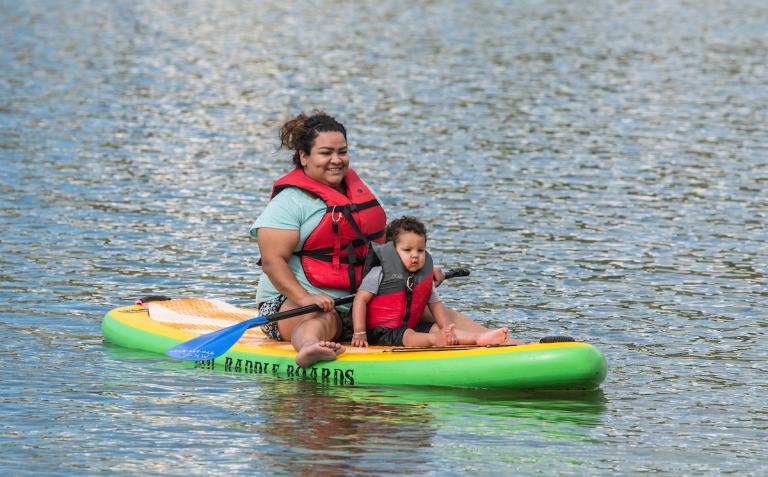Inclement Weather Office Closure:
The Colorado Parks and Wildlife Colorado Springs Office will be closed today, January 9, 2026, due to a snow event.
Inclement Weather Office Closure:
The Colorado Parks and Wildlife Colorado Springs Office will be closed today, January 9, 2026, due to a snow event.

Clean Your Gear
Clean, drain and dry your watercraft and gear — and Be a Pain in the ANS.
Find a watercraft and gear cleaning station now.
Find a cleaning stationVideo: Clean Your Gear — Prevent the Spread of Aquatic Nuisance Species
Be a Pain in the ANS
Join Sean, a Colorado Parks and Wildlife Educator, as he explores the harmful effects of aquatic nuisance species in Colorado’s freshwater ecosystems, along with simple steps you can take to prevent the spread of aquatic nuisance species
Be a Pain in the ANS!
Aquatic Nuisance Species spread by hitchhiking on watercraft, trailers, vehicles, tires, boots, waders, equipment, and gear. Be a pain in the ANS by cleaning your paddle board.
Video: Paddleboards — Prevent the Spread of Aquatic Invasive Species
How to
Learn how to clean, drain and dry paddleboard gear with Grace, a Colorado Parks and Wildlife Invasive Species Program Technician, and Ashley Coil, from Rocky Mountain Paddleboard.
Be a Pain in the ANS!
Aquatic Nuisance Species spread by hitchhiking on watercraft, trailers, vehicles, tires, boots, waders, equipment, and gear. Be a pain in the ANS by cleaning your kayak.
Video: Kayaks and Canoes — Prevent the Spread of Aquatic Invasive Species
How to
Learn how to clean, drain and dry kayaks and canoes with Grace, a Colorado Parks and Wildlife Invasive Species Program Technician, and Ashley Coil, from Rocky Mountain Paddleboard.
Be a Pain in the ANS!
Aquatic Nuisance Species spread by hitchhiking on watercraft, trailers, vehicles, tires, boots, waders, equipment, and gear. Be a pain in the ANS by cleaning your gear.
Be a Pain in the ANS!
Clean, drain, dry — and disinfect. Anglers should scrub the bottom of boots or waders with a brush and remove all mud, plants, and organic materials in between each and every use. Dispose of these contaminants away from other waters including drains to water systems.
Anglers should then perform one of the following options to disinfect their gear before going into the next body of water or moving to a new stretch of river.
Video: Angling — Prevent the Spread of Aquatic Invasive Species
How to
Learn how to clean, drain and dry angling gear with Grace, a CPW Invasive Species Program Technician, and Danny Frank, Owner of Colorado Trout Hunters.
Be a Pain in the ANS!
Divers can unintentionally spread freshwater invasive species from one body of water to another with contaminated gear. Some species are invisible to the naked eye and can survive hours to weeks on wet scuba gear or in water inside the equipment. By following these guidelines, you can help prevent the spread of invasive species when you scuba dive.
Be Part of the Solution!
Join the CPW volunteer scuba diving team.
Volunteer and recreational scuba divers help Colorado Parks and Wildlife each year by performing scientific scuba dives to monitor aquatic nuisance species and search for new invaders.
Colorado is a mandatory boat inspection state for motorized boats, sailboats and jet skis. Boaters with these types of watercrafts MUST be inspected by state certified personnel before entering the water in Colorado.
Mussels in a beer glass and mug
Be a Pain in the ANS!
Colorado's beer and breweries could be impacted by Aquatic Nuisance Species (ANS). Zebra, quagga, and golden mussels can attach themselves to the inside of pipes in massive numbers, forming dense clogs that reduce the amount of water that can be delivered. These species could prevent water from getting to farms that produce barley and hops, key ingredients in beer. Don’t let Colorado’s vibrant beer culture go flat. Tell Coloradans to say “Oh, SHELL NO” to invasive mussels by cleaning, draining, and drying all boating, paddling, and fishing gear after each use.
Coloradans use water from lakes, reservoirs, and rivers for many purposes, including drinking water, agriculture and irrigation.
ANS can enter lakes, reservoirs and rivers from water gear and move between bodies of water via irrigation systems, where they can reproduce rapidly.
ANS can build up in irrigation pipes, which can slow down water flow to crops.
Save the stouts, preserve the pilsners, love the lagers: Protect Colorado’s beer and breweries by cleaning, draining and drying your water gear.





